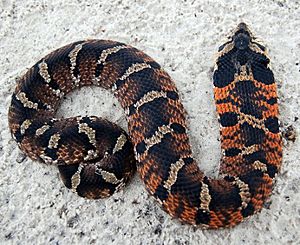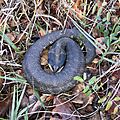Eastern hognose snake facts for kids
The Eastern hognose snake (scientific name: Heterodon platirhinos) is a cool type of snake found across North America. It's a colubrid snake, which means it's part of a large family of snakes. While it does have a mild venom, it's generally not harmful to humans.
Quick facts for kids Eastern hognose snake |
|
|---|---|
 |
|
| eastern hog-nosed snake (southern Georgia morph) |
|
| Conservation status | |
| Scientific classification | |
| Genus: |
Heterodon
|
| Species: |
platirhinos
|
| Synonyms | |
|
|
Contents
- What Does the Eastern Hognose Snake Look Like?
- Where Do Eastern Hognose Snakes Live?
- What Do Eastern Hognose Snakes Eat?
- Who Hunts the Eastern Hognose Snake?
- How Do Eastern Hognose Snakes Behave?
- How Do Eastern Hognose Snakes Have Babies?
- How Does the Hognose Snake Defend Itself?
- Is the Eastern Hognose Snake Venomous?
- Is the Eastern Hognose Snake in Danger?
- Images for kids
- See also
What Does the Eastern Hognose Snake Look Like?
An adult Eastern hognose snake is usually about 71 cm (28 inches) long. Its most special feature is its nose, which turns upwards. This upturned nose helps the snake dig easily in sandy soils.
Their skin can be many different colors. They might be red, green, orange, brown, gray, or even black. The color often depends on where the snake lives. Their belly is usually a solid gray, yellow, or cream color.
Where Do Eastern Hognose Snakes Live?
You can find Eastern hognose snakes in many places. They live from southern New Hampshire all the way down to the tip of Florida. They also live in the central United States, as far west as Texas, Oklahoma, Kansas, Nebraska, and even into southern South Dakota.
In total, these snakes are found in about thirty states in the United States. You can also find them in southern Ontario, Canada. They prefer dry areas with sandy or mixed sandy soils. They often live in grassy fields, farm fields, and along the edges of woodlands. Sometimes, they are found near small ponds or streams. They have even been seen inside buildings like greenhouses and barns.
What Do Eastern Hognose Snakes Eat?
The Eastern hognose snake mainly eats frogs. They also enjoy eating lizards, salamanders, insects, other small creatures without backbones, and tiny rodents.
Even though they are mildly venomous, their venom is not strong enough to hurt humans. It's more like the venom of a garter snake. They only have enough toxin in their saliva to make their small prey, like frogs, unable to move.
Who Hunts the Eastern Hognose Snake?
Many animals hunt the Eastern hognose snake. Some of their predators include raccoons, Virginia opossums, and red foxes. Birds like hawks also hunt them. Other snakes, such as common king snakes and cottonmouths, can be predators too. Even large spiders like tarantulas might prey on young hognose snakes.
How Do Eastern Hognose Snakes Behave?
Eastern hognose snakes are diurnal animals, meaning they are active during the day. They can swim to get from one place to another, or to find food and mates. They are usually active from early April until October or November, depending on how warm it is.
When the weather gets cold, usually around 19 degrees Celsius, they start to hibernate. They hibernate alone in burrows they dig themselves or in abandoned mammal burrows. At night, Eastern hognose snakes often dig into sandy soil to sleep.
How Do Eastern Hognose Snakes Have Babies?
Eastern hognose snakes mate in April and May. The female snake lays between 8 and 40 eggs in June or early July. They do not stay to take care of their eggs or their young after they hatch.
The eggs hatch after about 60 days, usually from late July to September. When the baby snakes hatch, they are quite small, about 16.5–21 cm (6.5–8.3 inches) long.
How Does the Hognose Snake Defend Itself?
When an Eastern hognose snake feels threatened, it has a very clever way to defend itself: it plays dead! It will flip onto its back, lie still, and sometimes even let its tongue hang out of its mouth to make it look more convincing. This trick often makes predators lose interest.
Is the Eastern Hognose Snake Venomous?
Many people think the Eastern hognose snake is not venomous because its bite is not harmful to humans. However, it does have a mild venom. If a human is bitten and is allergic to the snake's saliva, they might experience some swelling. But there have been no recorded human deaths from an Eastern hognose snake bite.
Is the Eastern Hognose Snake in Danger?
The Eastern hognose snake is currently listed as "least concern" on the IUCN Red List. This means they are not in immediate danger of disappearing. However, they could face threats in the future. These threats include habitat destruction, which means their homes are being destroyed. Also, a decrease in the number of toads, which are their main food source, could affect them.
Sometimes, Eastern hognose snakes are mistaken for pygmy rattlesnakes. Because of this, people sometimes kill them by mistake, thinking they are dangerous.
Eastern hognose snakes are important because they help control the populations of small mammals, insects, and amphibians. They play a big role in limiting the number of toads.
Images for kids
See also
 In Spanish: Serpiente de hocico de cerdo oriental para niños
In Spanish: Serpiente de hocico de cerdo oriental para niños










